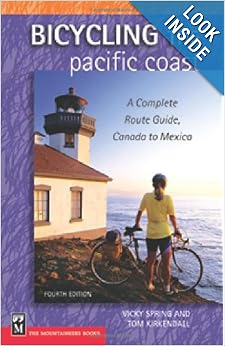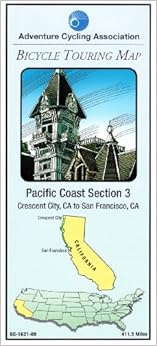Before cranking it up to 88 and activating the flux capacitor to thrust us back to December 2013, though, you must endure (suffer?) one last chapter (in two parts of course) of my bike history. It, surprise, surprise, starts with acquisition of yet another bike. As alluded to in my account of biking Big Sur, that trek was the last big road ride for the Bad Boy. While fantastic for commuting, and most weekend rides - the Bad Boy, with its unforgiving Cannondale aluminum, slightly undersized frame could be quite punishing when stringing several days of long rides together. My 430 mile trek to Pittsburgh, while glorious, left me with a case of tendinitis that took a month to overcome. Likewise, the Big Sur trip left me more sore than I should have been for a two day trip. The Cannondale had nobly served its purpose of adequately serving all purposes: commuter, road-bike, mountain-bike, beach bike, around-town-bike, etc.. But, after 13 years, and spending more and more time on the road, it was time to specialize and get a bonafide road bike that actually fit me.
As it so happened, the perfect bike to meet my needs (every day commuting around San Diego Bay, long rides on Saturdays and long treks every summer), and, especially, my modest budget, was a Specialized Secteur. An aluminum bike with the same, sleek geometry as the legendary Specialized Roubaix, and its super-forgiving carbon fork, the Secteur is a bike designed do take some of the jolts out of long-distance riding. So, it was off to Holland's in August of 2012 to order the first of the new 2013 models - which came in about 3 weeks later.
The Secteur definitely lived up to its billing. We ordered it to my size and then did a thorough in-store fitting when it arrived. When I tested it on a century ride a week later, I had no problem getting back in the saddle the next day (something I never did after going as far on the Bad Boy).
Now
that I had the right bike, it was time to get serious about my quest to
bike the entire Pacific Coast. Step One -- buy this book:
Those who bike the Pacific Coast refer to this as "the bible." Setting out to do any major chunk of the route from Canada to the U.S. / Mexico border without consulting this book would be, quite simply, irresponsible. Practically every mile of the coast is described along with road conditions, places to get food/water, distances between towns and campgrounds and hill profiles for every segment. While I prefer to average 70 miles per day (as opposed to the authors' preferred 40 - 60 miles per day - focused upon camping and campgrounds), it was very easy to convert their segments to mine. I'll offer only one critique here, though -- I completely disagree with the authors' approach to the San Diego -- which should be the last, triumphant, day for those biking the route north to south. They direct riders down the embarrassment that is Harbor Drive, blocked from the coast most of the way by industrial sprawl, taking them to the border crossing at San Ysidro (no coast in sight!). I hereby demand that the authors fix this tragic error by, instead, putting through-bikers on the ferry to Coronado where they can follow shoreline bikeway, under the glorious Coronado Bay Bridge, to the Strand bike path, where they can pedal the last 13 or so miles with water on both sides most of the way, through IB to the very end of the U.S. Pacific coastline. Now that would be a fitting end to biking the Pacific Coast!
Sorry, but I needed to vent a bit . . .
Step Two: Buy this map:
Compact
enough to keep at the ready in your handlebar or top-tube bag (yet
packed full of information) these maps are also indispensable for any
long trip along the coast. They are also great for ideas on alternative
ways to traverse the coast as the Adventure Cycling folks (and a
certain Bikeist) don't always completely agree with "the bible."
Between these two sources, I have always been able to choose the best
route for me.
Step Three: Ride
But
where and in what direction? Almost every rider I talked to after
doing Big Sur told me that if I loved that ride I really needed to get
up to the less-trafficked roads of far Northern California where the
scenery and riding closely resembled the conditions of Big Sur. Having
had such good luck with weather by doing Big Sur in July (no fog
whatsoever), I aimed for Fourth of July week to tackle Crescent City
(adjacent to the Oregon Border) to San Francisco. Why North to South)? Because you'd be crazy to do it the other way. Anyone who bikes the San
Diego County coastline knows that the prevailing wind runs North to
South. As it so happens, the same goes for the entire coast. While
this might not make much of a difference to a casual Saturday morning
rider, when you are stringing hundreds of miles together, having the
wind with you can be the difference between sheer pleasure and absolute
torture. I felt so sorry for the riders I saw slogging north as I
whizzed south toward San Francisco -- they clearly hadn't read the
"bible."
Living
in San Diego, I couldn't exactly just hop on my bike and start
pedaling, so logistics were crucial to getting this trek done. My
preferred means of getting me and my bike to far-flung rides is train,
since you can usually just walk your bike on, but train was not an
option for getting to Crescent City. Best way to go was to fly in via
puddle-jumper, but taking a bike would require dis-assembly and boxing
(a big pain and not conducive to getting going right away). So,
instead, I had my local bike shop mail my bike (surprisingly
inexpensive) to a shop in Crescent City where they expertly
re-assembled my bike and had it waiting for me right off the plane.
So, after a ten minute taxi ride from the airport I was able to start
pedaling south immediately: sweet!

Notice
the "Closed" sign? The owner, Tom (a legend for Pacific Coast
through-riders) came in on a Sunday just to give me my bike! Try tat in
a big city bike shop! Thanks, again, Tom!
Being
able to get in the saddle immediately on a Sunday afternoon, allowed me
to knock out one of the most dreaded portions of the Pacific Coast
Route - the climb out of Crescent City. I only needed to cover about 25
miles to get to the historic inn I had booked on the Klamath River, but
it required a long climb along a four lane highway with little or no
shoulder for several stretches. Lucky for me, Sunday afternoon traffic
was light, so I actually had a pleasant ride, getting out the kinks from
the flight as I climbed past the Redwoods which lined both sides of the
highway. When I arrived at the Requa Inn,
there was a salmon dinner waiting for me and a rocking chair on the
porch overlooking the mighty Klamath, where I saw an eagle swoop down
and snare his own salmon dinner . . .
Day one:
Remember this little guy?
He
and his family were the only ones to greet me as I headed out early (to
beat traffic, as usual) the next morning. Goal was the college town of
Arcata, home of Humboldt State - where the students and hordes of
homeless residents dominating the historic town square are virtually
indistinguishable. Besides the fact that I generally enjoy college
towns, I always try to use them as overnight spots thanks to the easy
access to laundry, food, and cheap lodging. The Hotel Arcata, right on "The Plaza" fit the bill perfectly.
The
58 miles from Klamath to Arcata took me down the Redwood Highway past
some of the largest and oldest organisms on the planet:
The only way to stand in the presence of these behemoths is in awe -- if you have never seen the Redwoods I highly recommend that you stop whatever you are doing at this moment and head directly to Northern California (the only place they exist except for a few groves that stretch just into southern Oregon). Any other course of action risks the possibility that you might die without having seen them in person - which would be a damn shame.
I love the unexpected finds along the way as well. This is the oldest movie theater in the United States - right around the corner from the Hotel Arcata and where I watched "Man of Steel" after sushi for dinner (always seem to find sushi after the first day of my big rides):
This was the ride I had been looking forward to for months and years -- 76 miles through the heart of Redwood country, and through the complete Avenue of the Giants.
It did not disappoint:
Luckily, traffic was extremely light on this Tuesday morning, so my ride was even more glorious than I might have expected. I stopped frequently to wander some of the groves, so it wasn't until mid afternoon, when I arrived at the Riverwood Inn, an authentic roadhouse with a bar, jukebox, stage and dance floor on the main level and cheap rooms right underneath. I ate my chili at the bar with real live lumber-jacks and some other interesting locals -- including a counselor at the prison camp that's operated nearby right in the middle of Redwood National Forest. He said that it was a working camp and that the setting did wonders for the prisoners sent there (who had to have spotless records at their previous facilities).
We'll pause here as this is already the longest post in Bikeist history and we still have three days of biking left -- including the dreaded Leggett Hill the morning after sleeping in the roadhouse. Get your rest loyal readers because there is some serious climbing ahead . . .
Up Next: Truly the end of the Bikeography -- I really mean it this time --









No comments:
Post a Comment